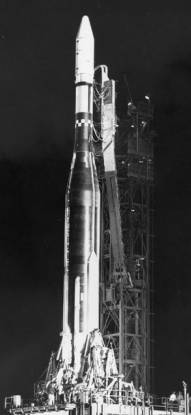
Most Agenas also had their own separate RSO charges, although NASA planetary probes omitted them for weight-saving reasons and due to the flight trajectory used, which meant that destruct of the Agena was no longer possible following staging. The Atlas's own RSO charges were also wired so that they would destroy both vehicles if activated.

During the coasting period between staging, the ISDS charges were disabled.
#ATLAS AGENA MIDAS 2 LAUNCH SERIES#
The ISDS charges were mounted on the adapter section between the two vehicles and would activate if a series of tripwires were broken. Some Atlas-Agena variants contained an Inadvertent Separation Destruct System (ISDS) to destroy the Agena in the event that it separated prematurely from the Atlas, a situation that could be caused by a booster hard-over or if the Atlas self-destructed in flight. One-off Atlas variant mating the last Agena stage flown to a refurbished Atlas F missile for the launch of Seasat. Used for OGO-5 and Canyon/Rhyolite SIGINT satellites. One-off Atlas variant used for the first OAO satellite.Įxtended tank Atlas. Standardized SLV-3 Atlas+Agena D used for a variety of NASA and Air Force programs, including Mariner, Vela, and Gambit. Standardized Agena B used for a variety of NASA and Air Force programs, including Ranger, Mariner, Midas, and Gambit. Used for a variety of NASA and Air Force programs, including Ranger, Mariner, Samos, and Midas. Variants Interactive 3D model of Atlas-Agena B NameĮarly Atlas-Agena variant flown four times for the Midas and Samos programsĮnhanced, restartable Agena. Launches were conducted from Launch Complexes 12, 13 and 14 at the Cape Canaveral Air Force Station, and Launch Complexes 1 and 2 at Point Arguello (now SLC-3 and 4 at Vandenberg Air Force Base). The last Atlas-Agena was flown in 1978 to launch SEASAT, but on a repurposed Atlas F missile rather than the SLV-3. Dozens of Atlas SLV-3/Agena D boosters were flown over the following years, mostly for the KH-7 Gambit program, also for a few NASA missions. The Atlas SLV-3 meanwhile first flew in August 1964. The Agena D first flew in July 1963 for DoD launches, but NASA continued using Agena Bs for the remaining Ranger missions. The end result was the Atlas SLV-3 and Agena D, standardized versions of the Atlas D core and Agena B which would be the same on every launch (at least as far as the Atlas was concerned, Agena Ds often still had customized setups, especially for DoD payloads). The board recommended improved quality control, better hardware, and also establishing one standardized launch vehicle for all space programs. The board found that quality control and checkout procedures were poor, and that this situation was exacerbated by the several dozen configurations of the booster, as each individual DoD and NASA program necessitated custom modifications to the Atlas and Agena, and the latter also differed in its Atlas and Thor variants. In late 1962, after Ranger 5 suffered another booster malfunction, albeit a minor one that ground controllers were able to work around, NASA convened a review board which undertook a wholesale reevaluation of the Atlas-Agena as a launch vehicle. Atlas-Agenas were then used for DoD and NASA programs, but proved a reliability nightmare as one failure after another happened. It first flew on the Thor and did not make its maiden voyage on an Atlas for months, when Midas 3 launched on July 12, 1961. Late in 1960, Lockheed introduced the uprated Agena B stage which was restartable and had longer propellant tanks for more burn time. Most of these were flown on Thor-Agena boosters for the Discoverer program and only four used Atlases ( Midas 1, Midas 2, Samos 1, and Samos 2), two of which failed. The earliest Agena variant was the Agena A in 1959–60, which did not have restart capability. The final Atlas-Agena launch used an Atlas E/F.


These were later replaced by the standardized Atlas SLV-3, and its derivatives, the SLV-3A and B. Initially, Atlas D missiles, redesignated as the LV-3, were used as the first stage. The Atlas-Agena was a two-and-a-half-stage rocket, with a stage-and-a-half Atlas missile as the first stage, and an RM-81 Agena second stage. However, the launch vehicle family was originally developed for the Air Force and most of its launches were classified DoD payloads. The upper stage was also used as an uncrewed orbital target vehicle for the Gemini crewed spacecraft to practice rendezvous and docking. It was used to launch the first five Mariner uncrewed probes to the planets Venus and Mars, and the Ranger and Lunar Orbiter uncrewed probes to the Moon. It was a member of the Atlas family of rockets, and was launched 109 times between 19.

The Atlas-Agena was an American expendable launch system derived from the SM-65 Atlas missile.


 0 kommentar(er)
0 kommentar(er)
